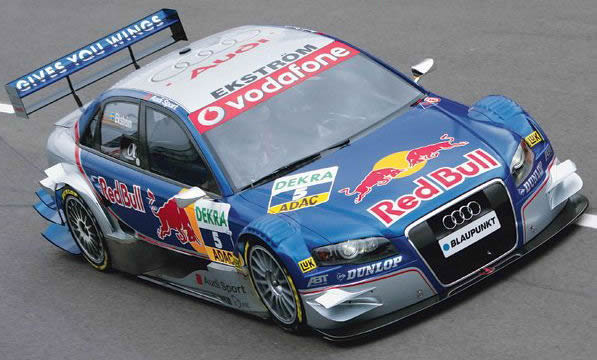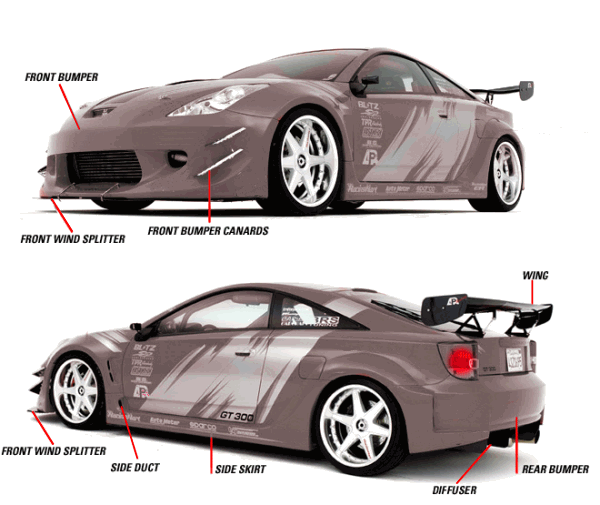Aerodynamic components for road going car

Audi TT, competing in Germany's DTM
There's little understanding of how or why aerodynamic aids work; people tend to bolt them on to feel the downforce placebo effect. We've already discussed the basics of drag, lift and flow, so in this part we'll talk about how several common aero aids work to make a car slick and stick.
For cutting-edge aerodynamics on production-based cars, look no further than Germany's DTM and Japan's Super GT cars. Both series have rules allowing significant use of aero aids (such as multi-element wings, diffusers, super-low side skirts, air dams, and splitters, canards and vortex generators) while keeping reasonably faithful to the cars' original lines.
These components combine to produce huge amounts of downforce, but there is a price for this amount of downforce. Drag. Redirecting the energy of the airflow to hold a car down creates more resistance for the car to push against. Sometime, if not optimized well this is just power kill.
The key is to produce just enough downforce to maximize the average speed around the track. Too much downforce and the increased drag will slow the car excessively, too little downforce will hurt cornering speeds. It usually takes huge amount of experimenting with wing settings and other components to find the sweet spot where performance is optimized.
By using some of the various aids below, you can properly tune the aerodynamic characteristics of your car not only for downforce, but also for cooling and stability. Some of these parts might be overkill in anything but competition, but all are readily available as bolt-on parts for most cars.

Aerodynamic parts are as important as any other modification one would put on their car for a performance gain. Just like any other performance modification, aerodynamic components require fine tuning to enable the driver to get the most out of it. Let's take a look at some common vehicle layouts to see the benefit of each type of aero component.
Lip spoilers, front diffusers, splitters, side skirts and canards are all components that can be utilized to product downforce in front of the vehicle. These components are especially useful to the following vehicles.
Front-Engine/Front-Wheel Drive:
Power output from Front-Engine/Front-Wheel Drive cars obviously comes from the front of the vehicle. At high speeds, vehicles tend to lift. This lifting effect reduces traction. To prevent the loss of traction, Front-Engine/Front-Wheel Drive cars can utilize components such as front splitters and front canards to give more downforce to the front of the vehicle allowing more power delivery to the ground from the engine.
Mid-Engine/Rear-Wheel Drive:
Since the center of gravity of Mid-Engine/Rear-Wheel Drive cars is near the center of the car, Mid-Engine/Rear-Wheel Drive cars tend to be lighter in the front of the vehicle. This gives MR cars a tendency to oversteer or snap (quickly kicking the back out) easily. To balance this effect, the use of front aerodynamic components can provide more traction in the front of the car.
Rear wings, spoilers and diffusers are all components that can be utilized to product downforce in rear of the vehicle. These components are especially useful to the following vehicles.
Front-Engine/Front-Wheel Drive:
Because vehicles are lighter in the rear, it is important to add more downforce in the rear to achieve more mechanical grip and aerodynamical balance. Rear wings and spoilers can do both of these effects.
Front-Engine/Rear-Wheel Drive:
The engine output from Front-Engine/Rear-Wheel Drive cars comes from the rear two wheels. To help delivery the output from the rear wheels, aerodynamic components such as rear wings and diffusers can help create downforce giving the rear wheels traction.
Any aerodynamic components require fine tuning, aero testing, and only then we can expect any gain. The shape and angle of any surface of a car is intended to produce downforce. If it is shaped incorrectly or angled wrongly it can create lift instead, and make car more unstable and more difficult to control. As you know from high performance cars and top racing, every components of the car must work together (aero upgrade, body, and undertray), otherwise results can be unpredictable. Other important point is manufacturing quality and used materials. You can't expect that aerodynamically loaded component, manufactured from low quality material withstand everyday torture. Can you imagine what will happen if on high speed, on well balanced car, suddenly left side canard or rear wing brake.
The best idea is to buy parts specifically designed for your car. There is a few producers of aftermarket parts which can guarantee the quality of their parts. Parts must be made of high quality materials (Carbon Fiber or high quality glass fiber composites). Each aerodynamic kit must be meticulously designed and produced to insure gaps between bumpers, fenders and side skirts adhere to high standards.
Whether aero devices installed on road-going cars are a genuine performance enhancement or simply a cosmetic modification?
How do you know if they work?
How can you measure the lift they are reducing?
Also is there any science behind the shape and attack angles?
First of all, on street cars traveling at legal or even near legal speeds such devices would make only a very tiny difference if any, and if you are traveling in such a manner that this tiny difference has any effect on your ability to control the vehicle, then you should stop this practice on public roads.
The amount of downforce generated is related to the speed of air passing over/under the wing. Faster speeds mean more downforce. Racing vehicles that use this technology are traveling two to three times faster than any street legal vehicle should be traveling, and they are dealing in hundredths of seconds for victories worth millions of dollars.
People who are attaching these wings or other aero aids to street legal vehicles are either using them only for decoration, or are modifying their vehicle with the intention of using it for racing. In some rare cases they are built into the design of a street legal sports car. Of course those vehicles are designed from the start to be street legal, but fully capable of competing in races right from the factory.
Many racing car manufacturers however are looking at the shape of the underside of their vehicles either to maximize downforce, or to minimize fuel consumption. The real racer will work on this area first before attaching any wings to his car.
If after reading this you still want to know exactly how much downforce the canard or wing will generate, then either the packaging should say, or the manufacturer's website should say. If they don't say, then assume it is only for decorative purposes, and will actually increase drag without improving performance.
To know more about aero devices and components check this articles:
Airbox
Bernoulli equation
Canards
Diffuser
Formula 1 Engine air intake
Gourney flap
NACA duct
Side duct
Side skirts
Wings






